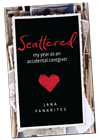At yesterday’s “Outside|In: Aging in a Tech World” event in DC, billed by host POLITICO as “a discussion of health technology’s role in an aging population, and how digital innovations are revolutionizing how we monitor and manage older adults’ physical and mental health – and help their family caregivers,” I was reminded of an old adage: you can lead a horse to water, but you can’t make it drink.
I’m pretty sure the horse/water proverb would produce who came up with that one? giggles from the millennials in the room (in the majority at this event, a sign if there ever was one that tech and older adults are not fast friends). But to this baby boomer the proverb speaks to a key challenge for the makers of healthcare technology: how to go about creating products for a group of consumers who may not want to engage with them.

Panel members l/r: Joanne Kenen, Health Editor, POLITICO; Jeannine English, President, AARP; David Lindeman, Dir., Center for Technology and Aging; Dir., CITRIS Health, University of California; Dr. Reena Pande, Chief Medical Officer, AbilTo; and Nora Super, Executive Director, White House Conference on Aging.
It’s not that older adults are incapable of engaging with technology, or that they’re uninterested in it. Research shows the opposite: Pew Study of Older Adults and Technology. The issue, as panel member Jeannine English noted, is that older people need to have a say in what sort of healthcare technology gets developed for them, and why. She added that we need to think in terms of living in place, not aging in place, and that technology should be part of that whole rather than compartmentalized.
Asking the aging population what sort of technology they need rather than forcing technology on them was a major theme at this hour-long lunchtime event, which moved from one topic to the next faster than a high-speed Internet connection. Panel member Dr. Reena Pande, Chief Medical Officer of AbilTo emphasized that when it comes to developing healthcare technology there is no one-size-fits all.
The important question to ask is: what does technology mean on a one-to-one basis? Dr. Pande stressed the need to think about the “behavioral piece,” not just the tech piece in developing health technology. When she said this, I remembered trying to get my senior mom to respond to the beeping alarm of her automated pill dispenser. Mom never took to that technology.
The tech world has been slow to embrace older people, and practical challenges abound despite innovations like the Medicare Blue Button app and AARP’s RealPad.
When it comes to delivering healthcare technology systems, we’re entering a brave new world, one where the greatest benefits will likely be seen in years to come by those enterprising millennials in attendance at this event.
In honor of that generation, which makes up a substantial portion of America’s caregivers as noted in this PBS Article, I’ve uploaded a bonus podcast this week featuring a perspective on aging from 29-year old Hilary Tone. You can listen to it here: Bonus Podcast Episode.
To view the full video of POLITICO’s thought-provoking event, go here: Outside|In.


 Scattered: My Year As An Accidental Caregiver is available in paperback and eBook at
Scattered: My Year As An Accidental Caregiver is available in paperback and eBook at



